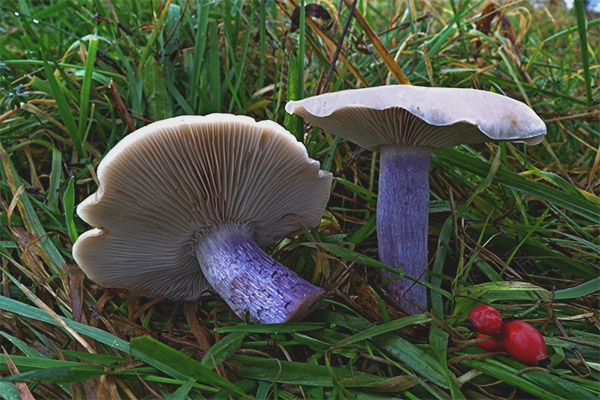The content of the article
Lilorium-legged ryadovka is a typical type of mushrooms of the ryadov family. To many mushroom pickers, this type of mushroom is known by the name Blue-tip, blue root. The peculiarity of these mushrooms is that, unlike similar species, they can grow even at rather low temperatures (up to –5 degrees), that is, they can be harvested even when most of the mushrooms no longer grow (until the end of November ).
Although this type of mushroom as a syringes and is considered edible (included in the 4th category), however, most of the mushroom pickers simply do not collect it, for fear of its toxicity because of the characteristic species.
The radius of the cap of this representative of the mushrooms in the rows reaches 80 mm, in its shape it resembles a cushion bulging in the upper part. The surface without any tubercles is smooth and light.Young rowing has a fairly dense flesh, but with the growing of the plant it becomes softer, friability increases. Directly the flesh itself is rich purple in color. Its main shade is white, gray or brownish. The smell of pulp is more like the aroma of fresh fruit, the taste is sweetish.
The inner part of the cap of the fungus has a lamellar structure, the plates of cream-colored are quite wide, spaced at some distance between them.
A stem of the same diameter along the entire length (up to 100 mm), at the base there is a slight thickening. Legs of young mushrooms are covered with flakes, which disappear with the growth of a blueberry.
Taste qualities
To taste, the lilac-legged ryadovka resembles mushrooms such as champignons, especially the blue-eyed beetle marinated or pickled. This edible mushroom has a low calorie content, but at the same time it contains a sufficiently large amount of protein, so this is the optimal solution for people seeking to reduce the calorie content of their diet.
Distribution of species
The first representatives of this species can be found already with the onset of the first heat, the latter - in the deep autumn. The peak growth of blueness is noted from August to September. It should be noted that experienced mushroom pickers recommend picking rylivonogi ryadovki exclusively in a dry time. This is explained by the fact that after the precipitation the fungus becomes rather slippery and sticky, which is why it is not easy to notice and inconvenient to collect.
The name of the mushrooms of this family is explained by the fact that blue-eyed bones, as a rule, grow in rows, while often the caps of one row cover the fruit bodies of another row. That is, from one meadow a lover of quiet hunting will be able to collect a whole basket of tasty mushrooms.
Also, this species is often found in areas adjacent to pastures. This is explained by the fact that the soil most suitable for the growth of these mushrooms is moist and humus-rich soil.
Although the ranches of the lilovogu and scare away many mushroom pickers due to their specific color, nevertheless, those who have tried these forest gifts will never refuse to collect these tasty mushrooms. As a rule, in one season, mushroom growers with experience from one place can harvest several yenen harvests (up to 140-150 kg).
Useful tips and advice on the collection and subsequent processing of syringes
- It is better to search for mushrooms for picking ryadovi lilovonogoy on open sunny glades, since in the thick of the forest this species is almost not found.
- When collecting mushrooms, it is better to immediately pre-process the mushroom (cutting off the lower part of the leg) so that it does not do at home. Then the processing of mushrooms will take much less time.
- It is better not to try raw mushrooms, despite the fact that they are edible, they can be poisoned, or you can confuse this species with its poisonous counterparts.
- Collecting broomsticks, be sure to cut off the lower part of old mushrooms - this is because the spores in the lamellar body are not digested, which can lead to intoxication of the human body.
- Before you start cooking your cinquefoil, mushrooms should be soaked in cold water for how many hours - this will effectively remove sand, vegetation and leaves that stick from the surface of the row. After soaking the mushrooms are washed several times, only after that you can begin to prepare them (implied heat treatment).
- Before soaking the mushrooms in the prepared water, add salt, this is done in order to rid the fruit body of the mushrooms from the worms.
- For cooking, do not use too old mushrooms or those rows whose fruit body is damaged, it is better to throw them away immediately - this will help reduce the risk of possible poisoning.
Similar views - what to look for?
By its appearance, this representative of the family of rowings is significantly distinguished from similar species. However, there are some species that are similar to it.
- Purple ryadovka - as already clear from the name, this mushroom has a corresponding color of all its parts. We draw attention to the fact that this type of rowing does not apply to edible, and it is not recommended to collect it.
- Also, weeds are similar to a chenoido, however, this type of mushroom has more modest dimensions.
- The fibrous rowing, unlike the blue root, has a hat of gray color, covered with a grayish-ash tinge.
These types of mushrooms should be avoided, as they do not belong to those species that can be eaten and pose a danger to humans.
In general, rowing with a blue leg is a completely edible mushroom with excellent nutritional qualities that will appeal to anyone.
Video: Lilac-legged row (Lepista saeva)












To send